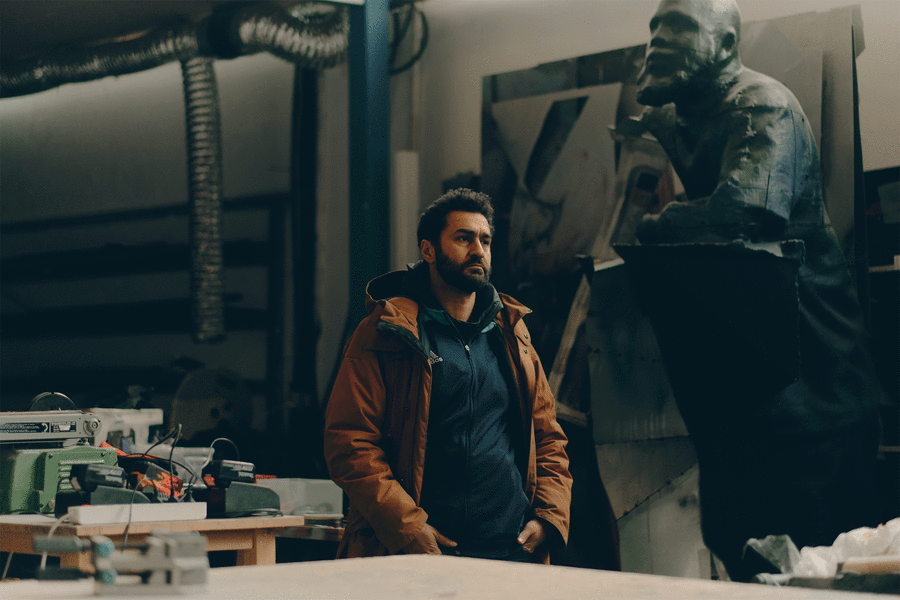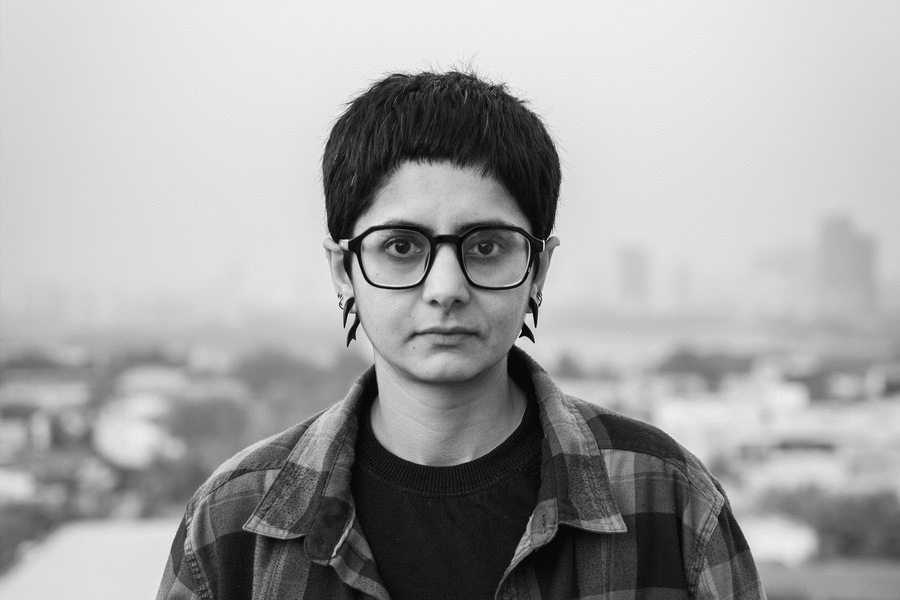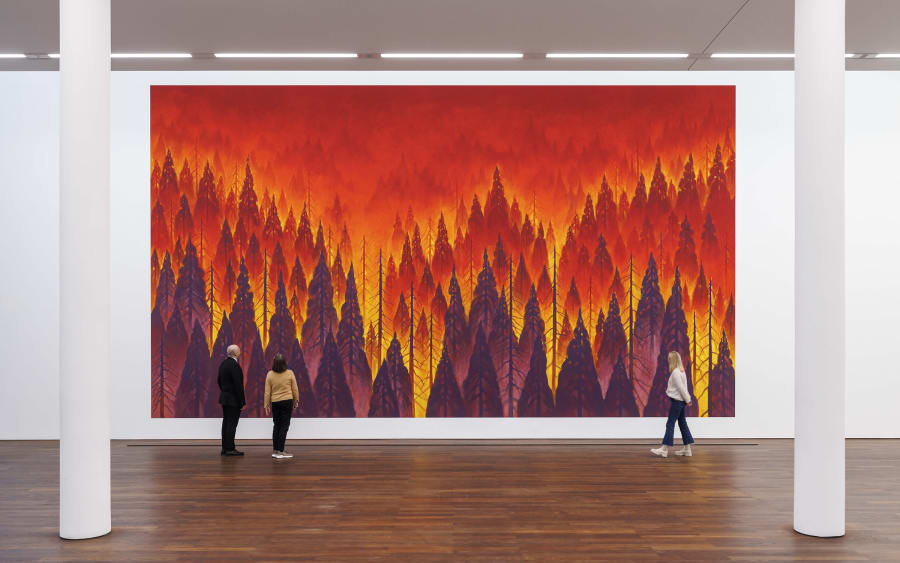In February 2005, when English designer Thomas Heatherwick spoke at Cape Town’s now-defunct Design Indaba conference, it was design that made the city a must-visit cultural destination. But today, art collectors flocking to the city every February for the annual Cape Town Art Fair outnumber the design aficionados. This year, concurrent to the fair, Cape Town is host to a vibrant program of exhibitions at galleries, museums, and project spaces like Breakroom, a new initiative launched by celebrated local artist Igshaan Adams. Here are seven exhibitions by a multi-generational group of South African artists worth seeing.
Ravelle Pillay
‘The weight of a nail’
Goodman Gallery
Through March 23, 2024
In her second solo exhibition with Goodman Gallery, Johannesburg-based artist Ravelle Pillay shows new paintings of a particular world wrought by colonialism. Pillay was born in the port city of Durban, a beachhead for South Africa’s Indian diaspora and the largest city in KwaZulu-Natal province. Her work references historical photos, public monuments, Victorian homesteads, and the lush landscapes of the region; colonial history, as Pillay recently said, played out in ‘incredibly beautiful, very uncanny environments.’ Her distinctive palette and painterly style recall Lisa Brice’s work from Trinidad, although Pillay’s paintings are firmly rooted in a vivid Indian Ocean imaginary – one with its own memories and chromatic hues. Queen and Country (2023), one of the largest works on view, transforms a historical photo of forgotten Indian troops from the South African War (1899–1902) into a haunting statement in blue.
Cinga Samson
‘Ukhe Nje Wasondela, Ndakuphosa Kulo Mlambo’
Norval Foundation
Through September 1, 2024
This early-career survey, the title of which translates to ‘If you come close, I will throw you into the river’, is the first to chronicle Cape Town-born painter Cinga Samson’s extraordinary rise to prominence. It tracks the artist’s evolution from neo-baroque painter of still life and vanitas scenes to – seemingly overnight – assured maker of oneiric portraits of young Black men set against sumptuous floral backdrops. The exhibition includes everything from the series ‘Lord forgive me for my sins ‘cause here I come’ (2015) – a trio of flower studies that bring Dutch Golden Age painting into conversation with rapper Tupac Shakur – to the 2023 tableau, Closely Analyzing an Unknown when Unknown, which shows a group of men with pupilless eyes gathered around a sisal plant. Whether painting plants, people, or both, Samson has a knack for synthesizing diverse influences – Western genre painting, celebrity photography, contemporary music, Xhosa myth – into something authentically his own.
Mawande Ka Zenzile
‘uZenzile akakhalelwa’
Stevenson
Through March 9, 2024
‘I just want to have fun, I have no desire to change the world,’ Cape Town-based painter Mawande Ka Zenzile remarked during the opening of his ninth solo exhibition at Stevenson. The exhibition’s title references an idiomatic expression in Xhosa and Zulu about risk taking not inviting sympathy, much like intentionally skating on thin ice. Ka Zenzile’s new paintings – displayed amidst fragrant straw strewn on the ground and bales of hay lining the walls – echo these sentiments of play and risk. In his work, Ka Zenzile, also a practicing healer, embraces Indigenous knowledge and the cosmic freedom of pure color. He uses cow dung – a resonant material, practically and spiritually, for Xhosa people – instead of traditional oil or acrylic paints. This material choice also reflects why he studied sculpture at university: ‘to avoid being influenced by Westernized academic painting practices,’ he says. And yet, works like the diptych Amawele kaSilevu (2024) resonate with their clouds of color painted in a manner reminiscent of Clyfford Still.
Chris Soal
‘Surface Tension’
Whatiftheworld
Through March 9, 2024
Johannesburg-born and Cape Town-based artist Chris Soal is best known for labor-intensive wall sculptures made from wooden toothpicks and bottle caps – ‘materials of ubiquity,’ as he describes them – that he organizes into swirling and trailing abstract forms. The rationale behind these earlier works informs those on view at Whatiftheworld, where new floor and wall sculptures are made from cast-off sanding discs that Soal patiently collected over the past two years. The show also includes a new series of works made from rolls of sandpaper abraded on a woodblock until the carved image is revealed through the paper’s erosion. In the case of largest work, The Expanse (To See The World in a Grain of Sand) (2024), a rippled body of water appears in textured black and the blue of the sandpaper’s base. These frottage compositions extend Soal’s recurring reflection on the themes of obsolescence and repair.
Unathi Mkonto
‘To Let’
Zeitz Museum of Contemporary Art Africa
Through February 25, 2024
Until recently, Peddie-born Cape Town-based artist Unathi Mkonto was something of a local gem, but taking up residency in Zeitz Museum of Contemporary Art Africa’s dedicated atelier has definitively changed that. Open to all museum visitors, Mkonto’s temporary studio also functions as a densely packed display of new drawings and sculptures that extend the formal language of his earlier works – notably a series of billowing cardboard sculptures included in an exhibition with photographer David Goldblatt at Stevenson last year. Mkonto’s fidelity to the draughtsman’s line draws on his formal training in both architecture and fashion design. However, a montage of personal photographs points to the vital influence of informal architecture on his choice of materials and understanding of permanence in sculpture.
Asemahle Ntlonti
‘Inzonzobila’
Blank Projects
Through March 28, 2024
For her second solo exhibition at Blank Projects, Cape Town-born artist Asemahle Ntlonti is showing new mixed-media works on canvas. Neither paintings nor collages, these layered and abraded compositions feature sewn and glued bits of thread, paper, and acrylic gel in what she calls ‘shy colors’ that interrupt the fields of unevenly painted acrylic. The new body of work evolves ideas and processes first explored in 2022; in these earlier works the artist overlaid thread, paper, and acrylic gel onto painted patterns and colors that evoked the walls of her grandparents’ ancestral home in the Eastern Cape. Rendered in even softer tones and textures than before, the pieces in ‘Inzonzobila’ (which loosely translates from Xhosa as ‘abyss’ or ‘very deep water’) operate like fictional maps to lost memories. The artist has likened the process of making these works to having ‘conversations with my people.’
Esther Mahlangu
‘Then I Knew I Was Good at Painting’
Iziko South African National Gallery
February 18 to August 11, 2024
Esther Mahlangu was 10 when she began painting murals at her rural home in Middelburg in the early 1940s. Now 88, she remains a prolific painter whose work will be included in the forthcoming 60th Venice Biennale and whose decades-long career is explored in this expansive survey. Mahlangu’s works are immediately recognizable for their black-outlined geometric patterns filled in with bright colors, a distinctive style that draws extensively from the female-led mural traditions of the Southern Ndebele people. Her capacity to translate this idiomatic language across two- and three-dimensional surfaces – be it canvas, sculpture, or spangly consumer objects – is showcased here through the presentation of roughly 100 artworks. Highlights include a boxy BMW, which she painted in 1991 as the first African artist invited to participate in the BMW Art Cars project, and a recent roundel painting, Ndebele Abstract (2023), in her admired style.
Sean O’Toole is writer and curator based in Cape Town. He has published two books and his recent chapbooks include The Object and The Green Interior, both 2023.
Caption for full-bleed image: Cinga Samson, Ukuphicothwa kwento xa ingaziwa (detail), 2023. Courtesy of the artist and the Norval Foundation.


